|
|
|
Termite is the common name of a group of chemically complex
insects that live in communities as ants do. They have long been known as white
ants however this is not entirely accurate for termites are like ants only in
their habits of living together and that they are small in size. Actually
termites are more closely related to cockroaches and grasshoppers.
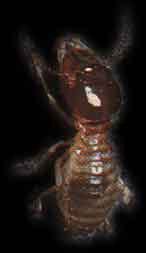
Their mouth parts, antennae, thick waists, primitive wings and
other features resemble those of cockroaches. Termites are
found almost all over Australia. Some termites build huge
mounds of bits of soil mixed with wood saliva. These nests may
be 6 metres high. The inside of the mound is divided into
various chambers and galleries. In the centre is a closed cell
where the queen is kept. The queens’ body goes under
extraordinary change. Her body swells up to hold thousands of
eggs. The queen lays the eggs at the rate of several thousand
a day.
Studies in the U.S. have revealed that termites cause as much property
damage each year as fire does.
Termites digest wood , paper , and other material
containing cellulose, with aid of protozoain their bodies. They do much damage
in tunnelling through the wood work of houses destroy books and furniture , and
do great damage by tunneling through fence posts, trees , timbers of wooden
buildings, bridges ,trestles , and other structures. In houses they eat , cloth
furniture, books and paper.
|
|
|
|
|
|
A termite
inspection is an inspection of the building and property including roof
void, sub-floor, internal and external timbers, and trees and fences within
the property boundaries.
It
deals with the detection or non-detection of live termite activity, and
evidence of termite damage, and includes details of areas of risk.
A pre-purchase inspection should be carried
out before a property is purchased, and is an inspection of the
building and property including roof void, sub-floor, internal and
external timbers, and trees and fences within the property
boundaries.
It deals with the
detection or non-detection of live
termite activity, borer activity, timber decay, chemical
delignification, and evidence of damage caused by these pests and
includes details of areas of risk.
|
|
|
|
|
|
 Everything
looks OK, how do I know if I have termites? Everything
looks OK, how do I know if I have termites?
 You may not see any signs of termites until it's
too late. The only way you can be really sure you don't have termites
is to have an annual Timber Pest Inspection by a qualified timber pest
inspector. You may not see any signs of termites until it's
too late. The only way you can be really sure you don't have termites
is to have an annual Timber Pest Inspection by a qualified timber pest
inspector.
 How
are you different to other pest management companies? How
are you different to other pest management companies?
 We
are environmental pest controllers with special training in this field. We
are committed to making a difference and our focus is on risk
reduction. Unlike other companies, we put your health and environment
first. We
are environmental pest controllers with special training in this field. We
are committed to making a difference and our focus is on risk
reduction. Unlike other companies, we put your health and environment
first.
 If
you don't use chemical sprays, what do you use and does it work? If
you don't use chemical sprays, what do you use and does it work?
 We
design a pest management strategy that focuses on non-chemical
controls.The strategy will be designed
specifically for your problems and needs. We may use localised
low-hazard treatments for certain pests. We
design a pest management strategy that focuses on non-chemical
controls.The strategy will be designed
specifically for your problems and needs. We may use localised
low-hazard treatments for certain pests.
 What's
the first step? What's
the first step?
 The
first step is a thorough, detailed, systematic inspection of your
home. The
first step is a thorough, detailed, systematic inspection of your
home.
 How
long does it take? How
long does it take?
 Depending
on the site, the first inspection for timber pests will take around 2
to 3 hours. Depending
on the site, the first inspection for timber pests will take around 2
to 3 hours.
 Will
I get value for money? Will
I get value for money?
 What
is your home worth? Can you afford to not give your home a yearly
safety check. It's a critical part of maintaining your home. Contact
our office for a free phone/email quotation. What
is your home worth? Can you afford to not give your home a yearly
safety check. It's a critical part of maintaining your home. Contact
our office for a free phone/email quotation.
 Will
I have to leave the house during the inspection? Will
I have to leave the house during the inspection?
 Not
usually. Most work can be undertaken with you at home. Not
usually. Most work can be undertaken with you at home.
 What pests do you deal with? What pests do you deal with?
 Pests are simply creatures in the wrong place at
the wrong time. We have on-site action plans for termites, borers,
fungal decay, cockroaches, ants and rodents. We will provide free DIY
information for all other pests including spiders, fleas, silverfish
etc. Pests are simply creatures in the wrong place at
the wrong time. We have on-site action plans for termites, borers,
fungal decay, cockroaches, ants and rodents. We will provide free DIY
information for all other pests including spiders, fleas, silverfish
etc.
 I'm
building a new house, or extending my current house. What should I do
to keep termites out of my new home? I'm
building a new house, or extending my current house. What should I do
to keep termites out of my new home?
 There are many
options available for minimizing the risk of termite entry into your
new home or renovation. It will depend largely on the construction of
your property and we will recommend the best options for your specific
circumstance. The methods that we recommend may include physical
barriers, chemical barriers and combinations to ensure that you have
the best protection available.
There are many
options available for minimizing the risk of termite entry into your
new home or renovation. It will depend largely on the construction of
your property and we will recommend the best options for your specific
circumstance. The methods that we recommend may include physical
barriers, chemical barriers and combinations to ensure that you have
the best protection available.
|
|
|
|
Termites are the
only members of the insect order Isoptera.
They are commonly
known as “White Ants”.
However termites are
not even closely related to ants. Ants have eyes, a constricted waist
and dark bodies, whereas most worker and solder termites are blind, have
no constriction and are creamy in colour.
There are more than
300 species found in Australia but only about 30 could be considered to be
pests of timber in service. Of these, the subterranean termites are the
most significant, with about 12 species being serious pests. The termite
diet is centred around cellulose-based materials. These can include the
timber used in constructing buildings but could also include furniture,
paper materials and fabrics. These termites can also damage non-cellulose
materials such as polystyrene and plasterboard or the plastic coatings on
electrical wiring.
|
|
|
|
Termites are social
insects and live in colonies containing a number of different castes. Each
caste has a different form and function from the others; each is vital to the
viability of the colony. In general terms the life history of all the
economically important subterranean species is similar.
Alates
On a warm, humid evening
large numbers of winged male and female termites, the “alates” or “primary
reproductives”, are released by the colony. A small number survive the flight,
drop their two parts distinctive, equal sized wings, pair off, mate, and if they
can find a suitable location, start a new colony.
Queen
As the other castes take
over the running of the colony the young queen of most species becomes
“physogastric” – her abdomen distends to many times its original size and she
becomes an egg laying machine, laying up to 1000 eggs per day. She is confined
to her royal chamber, tended and fed by the workers and regularly fertilised by
the male reproductive.
Nursery
The eggs are removed from
the royal chamber and transferred to a nursery by the workers. Here the brood
(the eggs and nymphs) develop into the other castes that the colony requires for
development and survival; workers, soldiers and primary or secondary
reproductives.
Soldiers and Workers
Soldiers and workers are
blind and sterile termites. The workers carry out the work of the colony and
are responsible for gathering the food the colony needs. In most species, the
heads of the soldiers are uniquely armoured and equipped to allow them to defend
the colony against attack, notably ants.
|
|
|
|
Coptotmermes
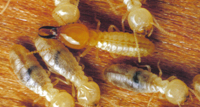
|
Coptotermes acinaciformis is found throughout mainland Australia and causes more
damage to property than any other species. It is aggressive in its search for
food and will attack many items other than wood in its search for cellulose
materials. It will damage wall lining boards, electrical wiring and even
personal possessions. Colonies often nest in trees or stumps but can form nests
without ground contact.
|
Nasititermes
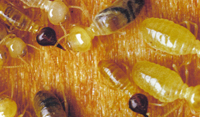 |
There are several
species of Nasutitermes which may damage timber in service. Soldier termites
of these species are distinguished by their pointed heads. Nasutitermes
exitiosus usually builds a low mound and is more common across Southern
Australia. Nasutitermes walkeri builds part of its colony as a nest on the
branch of a tree; the rest is constructed in the ground beneath it. This
genus will mainly attack hardwood such as that found in fences and timber
decking.
|
Mastotermes
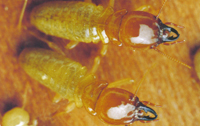 |
Mastotermes darwiniensis,
the Giant Northern Termite, is the most primitive of the commercially
significant species. It shows an ability for sub-colonies to split from the
main colony and produce queens, without a mating flight. Eventually a network
of interconnecting sub-colonies is established, which makes control difficult.
These large termites can devastate buildings, bridges, poles, trees and crops
such as sugarcane. Mastotermes is found mainly north of the Tropic of
Capricorn.
|
Schedorhinotermes
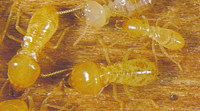 |
These termites can cause
damage approaching the severity caused by Coptotermes. They build fragile
nests in places such as old tree trumps, in timber buried in the ground, in
filled patios and under fireplaces. The damage they cause is distinctive.
Although it can be severe it is often patchy, with huge gouges taken out of
sound timber, particularly around nails in floor boards or other timbers.
Schedorhinotermes colonies contain major and minor soldiers.
|
Heterotermes
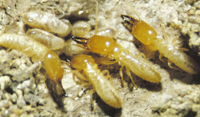 |
Heterotermes spp. Are a
significant structural pest through Queensland, northern WA and the NT. It is
only in southern Australia where they are a minor nuisance. They are generally
considered to do little damage to timber in service, restricting their attention
to weathered timber fences, decking and posts. Occasionally they can cause
superficial damage to sound timber.
|
Termite Nest
 |
Termites build a nest that
contains the queen and king, the nursery and a large proportion of the soldiers
and workers. Some species build a hard-shelled mound above or partly below the
ground. Others build their nests in the trunk of a tree or below ground in the
root crown. A nest can contain several million termites. |
|
|
|
|
Nesting Habits
The nesting habits of subterranean
termites can be described in two basic groups:
1.
Multi-site nesters (Heterotermes, Schedorhinotermes, Mastotermes)
2.
Central-site nesters (Coptotermes, Nasutitermes)
Multi-site nesters utilise many timber
sources for nesting and they can move quickly to a new food source. They
are able to reproduce quickly using “ergatoid” or multiple
reproductive forms so each new timber source located becomes a potential
nest. These species can therefore set up multiple colonies within the
same house.
Central-site nesters generally have one
large queen and a central nest position. The activity of the colony is to
bring back food to this nest. They can infest multiple timber food
sources but cannot reproduce within those timbers. When a moisture source
is available within a house structure, central-site nesters often
establish their colony inside the building without any ground contact.
Foraging behaviour
Central-site nesters show definite
seasonal variation with their foraging behaviour. Generally, foraging
activity is greater in the warmer months and reduced in cooler winter
periods. The available moisture can also limit the foraging activity of
these species. Generally distant food sources show greater foraging
activity in warmer periods and food sources close to the nest are more
active in the cooler months.
Multi-site nesters do not have the same
restrictions as they can move their nest to adjacent food sources. This
type of foraging activity often leads to splitting of one colony into
several distinct colonies within the same area. The activity of these
species quickly multiplies in a disturbed environment such as recently
cleared land or fire damaged property.
Termite leads
Termites are prone to desiccation.
All significant species that attack buildings construct a system of sealed
leads that connect the nest to the food sources. Termites can move
safely from the nest to the food and back, in an environment that will
protect them against exposure to atmospheric conditions, predators and
even pesticides.
Damage to timber and other materials
Timber is the main source of cellulose
sought by the commercially important species. Sometimes other, non
cellulosic materials are damaged because they are close to feeding
activity. Electrical wiring, switches and plug fittings are often
attached and severely damaged by termites. When natural food supplies
such as trees run out, the termites will turn to timber in service. Using
covered mud tunnels to link the food supply to the nest, termites will
work in timbers that are hidden in floor, wall or ceiling spaces and the
damage is often not discovered until structural failure takes place or the
termites reveal themselves in some way. Termites can cause extensive
damage and more than one colony may attack a building at the same time.
In order to minimise the extent of
termite damage it is recommended that regular inspections be carried out
by a competent and experienced termite inspector.
|
|